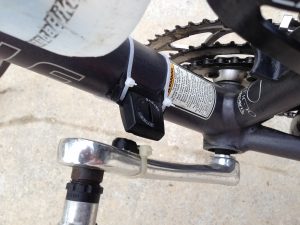Getting a chance today to do something I love to do, that’s talk about the mathematics, physics, and physiology of bike riding. Today I want to do something that has not been done to my knowledge and that is to convert a cheap, or at least, inexpensive cycle odometer, speedometer, computer into a more expensive cadence meter. I’m going to do that by changing the way we do the measurement of the going around and around of the front wheel to going around and around of the pedal.
Cadence is a very important measurement. It’s that measurement of times per minute that we are moving the pedals around. That’s very different from the speed of which the front wheels are going around, which is how fast you are going in kilometers per hour or miles per hour. It is a very important thing, but it doesn’t really have anything to do with how we are training. As we train we are trying to optimize our physical performance when you are going uphill or downhill or against the wind that can be a big deal as far as your speed goes but your cadence can be the same and we can be optimizing training for that higher cadence. The same cadence that that you look at in the Olympics or high end bike riders on the Tour de France they’re peddling at 80 to 90 to 100 revolutions per minute. People, especially us older riders, tend to go slower, 50 to 60, just because that’s where our physiology and our bodies find to be most energy efficient. I’ll talk about that more in a different video. Today I want to talk about the magic numbers to turn this into this, at least as far as a cadence meter goes.
So, what I’m going to do is a little bit of high school math and I’m going to show the magic number to type in the inexpensive bicycle odometer to output cadence as opposed to speed. Now, we’re going to have to move the sensor locations and that kind of thing but I’ll get to that in a minute.
We’re going to focus on the optimum speed of the cadence of your cycling, your pedaling action, as opposed to speed action, of 80 revolutions per minute. I’m just going to use that as an example number to calculate the circumference of an imaginary tire that you would have to put on the bike to dial in our inexpensive cycle odometer. Now, these odometers have different sized wheels that you can use and the magic number you type in is the circumference. So, little kid’s bike, a road bike, that changes to make the miles per hour more accurate. But, we’re going to change that to a totally different number to relate cadence of the pedal and pretend that is a kilometer per hour measurement. Now, we’re optimizing say 80 to 90 revolutions per minute as a cadence, we’re not going to be going anywhere that in kilometers per hour so I’ve made another change and that is to divide that speed by 10. So a 80 revolutions per minute cadence, I want to dial this in to be 8 to 9 kilometers per hour.
Now to do the math I’ve just chosen one of these numbers, it could be any number, or even “X” if you remember high school math. I’m just going to do this conversion. Watch this: I’m going to target 80 revolutions per minute, calculate this circumference value (that’s what we’re going to solve for), do the conversions from minutes to hours and meters to centimeters, and kilometers to meters and make that come out to 8.0 kilometers per hour as opposed to 80 revolutions per minute. But that’s the same number, that’s the number that is going to come up on our bike odometer. I’m going to do the math and I’m going to calculate the circumference of 166 centimeters. That is the magic number that we are going to type into the bike odometer to make the output revolutions per minute – if we move the sensor to the pedal.
I’ve got a picture below of where I’ve set my bike up to be. I’m using the same magnet as my expensive Garmin 810 cadence meter that does a whole lot more. I’ve shared that same magnet and I’ve placed the sensor to pick up every time the pedal goes around and send that signal to the little odometer. What comes out is a kilometer per hour value that is actually revolutions per minute on our cadence.

You see that video? It shows that these things match. You wouldn’t believe how difficult it is for me, uncoordinated ol’ me, to get the picture in focus and everything. But it works! The numbers match up on the expensive device and the inexpensive device. It was kind of fun riding around the neighborhood balancing all the stuff and trying to take this picture even though people look at you and say, “Oh my gosh what is this crazy person doing?”
Anyway, this is Ken from OldManRider getting a chance to physics and math today, enjoying the opportunity to mix my professional life and my personal life and teach you how to convert this device into this device and hopefully save a whole lot of money and get the tools you need to be a better rider.
